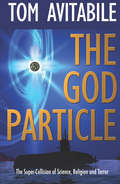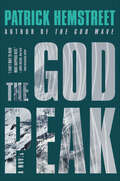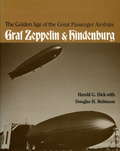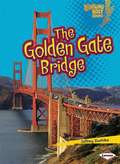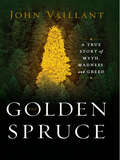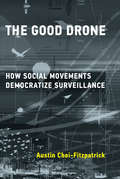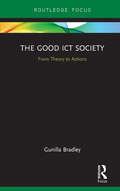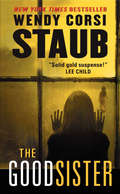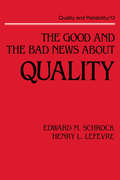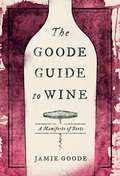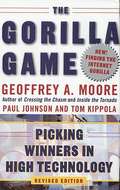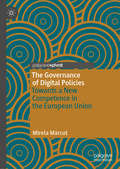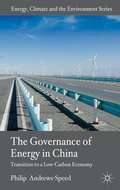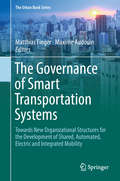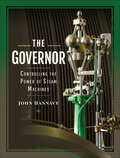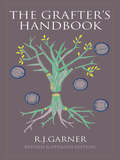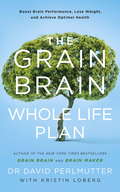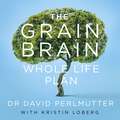- Table View
- List View
The God Particle
by Tom AvitabileWhen the smallest imagined particle of matter threatens to destroy all that matters, science and religion collide on the world stage and within the corridors of power. Presidential Science Advisor William "Wild Bill" Hiccock and his top-secret Quarterback Operations Group (QUOG) has already faced down some of the most sinister high-tech rivals imaginable. Now they must face one that can eliminate all life on Earth in an instant.THE GOD PARTICLE is a super-kinetic thriller that pits brains, religion, political power, and common humanity against the onslaught of extremely dangerous, narrowly focused scientific exploration into the fabric of creation, complete with a plot to shoot down one of the President's helicopters. Fringe religious groups - but not the usual suspects - engage in terror. Ugly espionage is set against the beauty of the Cote D'Azur. The romance of Paris offsets the grit of Boston's South of Roxbury while the Euro-pop discos of Switzerland punctuate the quest.In the end it comes down to one question: Can former FBI agent Brooke Burrell, now QUOG's lead operative, choose between her personal and professional life in time to solve the puzzle and stop it all?
The God Peak: A Novel (The\god Wave Trilogy Ser.)
by Patrick HemstreetThe sequel to the critically acclaimed The God Wave is a “fast-paced, thought-provoking techno-thriller” about a coup by genetically engineered humans (Publishers Weekly). Chuck Brenton had a simple idea: if brain waves can make the needles on an EEG machine move, why couldn’t they be trained to move other things? He and mathematician Matt Streegman developed an astonishing program that enabled a group of highly select individuals—test subjects they called the Alphas—to use their brains to manipulate both physical and digital objects. Their goal was to increase man’s potential and make the world safer.But when their secret program was discovered, the military stepped in to take control—and unwittingly began a battle that could spell the end of humankind. A trio of renegade Alphas have used their enhanced powers to take the world hostage. Though they say they want world peace, the rebels seem willing to sacrifice countless innocent lives to achieve their goals.Horrified by what he has unleashed, Chuck is determined to stop the monsters he’s created, no matter the risks. Coming out of hiding, he and his team must wield their own burgeoning abilities to defeat the increasingly unstable superhuman terrorists.Yet not everyone believes what the Alphas are doing is wrong. A cadre of supporters sees them as the next phase in human evolution and is eager to watch them burn down society on their way to transcendence. . . .“I can’t wait to read what happens next.” —James Rollins, #1 New York Times–bestselling author of the Sigma Force series
The God Wave: A Novel (The God Wave Trilogy)
by Patrick HemstreetA team of neuroscientists uncovers amazing new capabilities in the brain that may steer human evolution toward miraculous and deadly frontiers in this spectacular debut work of speculative science fiction—Limitless meets James Rollins—that combines spirituality and science in an inventive, mind-blowing fashionFor decades, scientists have speculated about the untapped potential of the human brain. Now neuroscientist Chuck Brenton has made an astonishing breakthrough. He has discovered the key—the crucial combination of practice and conditioning—to access the incredible power dormant in ninety percent of our brains. Applying his methods to test subjects, he has stimulated abilities that elevate brain function to seemingly “godlike” levels. These extraordinary abilities can transform the world, replacing fear and suffering with tranquility and stability. But in an age of increasing militarization, corporate exploitation, and explosive technological discovery, a group of influential power brokers is determined to control these new superbeings for its own manipulative ends—and its motives may be far from peaceful.
The Golden Age of the Great Passenger Airships
by Douglas Robinson Harold DickDrawing on the extensive photographs, notes, diaries, reports, recorded data, and manuals he collected during his five years at the Zeppelin Company in Germany, from 1934 through 1938, Harold G. Dick tells the story of the two great passenger Zeppelins. Against the background of German secretiveness, especially during the Nazi period, Dick's accumulation of material and pictures is extraordinary. His original photographs and detailed observations on the handling and flying of the two big rigids constitute the essential data on this phase of aviation history.
The Golden Gate Bridge
by Jeffrey ZuehlkeBefore the Golden Gate Bridge was built, people in San Francisco took a ferry across the water to get to Marin County. Now they drive across. How long is the bridge? and how did workers build it?
The Golden Spruce: A True Story of Myth, Madness, and Greed
by John VaillantA tale of obsession so fierce that a man kills the thing he loves most: the only giant golden spruce on earth. When a shattered kayak and camping gear are found on an uninhabited island in the Pacific Northwest, they reignite a mystery surrounding a shocking act of protest. Five months earlier, logger-turned-activist Grant Hadwin had plunged naked into a river in British Columbia's Queen Charlotte Islands, towing a chainsaw. When his night's work was done, a unique Sitka spruce, 165 feet tall and covered with luminous golden needles, teetered on its stump. Two days later it fell. As vividly as John Krakauer puts readers on Everest, John Vaillant takes us into the heart of North America's last great forest.
The Golem at Large
by Harry Collins Trevor PinchIn the very successful and widely discussed first volume in the Golem series, The Golem: What You Should Know About Science, Harry Collins and Trevor Pinch likened science to the Golem, a creature from Jewish mythology, a powerful creature which, while not evil, can be dangerous because it is clumsy. In this second volume, the authors now consider the Golem of technology. In a series of case studies they demonstrate that the imperfections in technology are related to the uncertainties in science described in the first volume. The case studies cover the role of the Patriot anti-missile missile in the Gulf War, the Challenger space shuttle explosion, tests of nuclear fuel flasks and of anti-misting kerosene as a fuel for airplanes, economic modeling, the question of the origins of oil, analysis of the Chernobyl nuclear disaster, and the contribution of lay expertise to the analysis of treatments for AIDS.
The Goliath Stone
by Larry Niven Matthew Joseph HarringtonScientists must stop nanites from driving an asteroid into Earth in this “brilliantly crafted . . . edge-of-the-seat thriller” (Kirkus Reviews, starred review).Twenty-five years ago, Doctor Toby Glyer and William Connors made a revolutionary breakthrough in nanotechnology. Their controversial nanites were capable of everything from miracle cures for the terminally ill to AI for asteroid-mining missions. But when the nanite-run Briareus mission to divert an Earth-crossing asteroid dropped out of contact soon after reaching its target, the entire program was shut down and the use of nanotechnology forcibly suppressed.Now a much, much larger asteroid is on a collision course with Earth—and the Briareus nanites may be responsible. While governments scramble to find a solution, Doctor Glyer knows that their only hope to avoid Armageddon lies in the nanites themselves. On the run, Glyer must track down Connors and find a way to make contact with their wayward children before a two-hundred-gigaton asteroid smashes into Earth. Will Glyer’s be Earth’s salvation, or destruction?Praise for The Goliath Stone“A fast read, filled with fascinating characters and mind-binding concepts. I should have worn a crash helmet.” —Larry Bond, New York Times–bestselling author of Shattered Trident“A future so brilliantly rendered that it feels shockingly real. This stunning book is Niven at the absolute top of his game, a surefire award winner and fan pleaser.” —Whitley Strieber, New York Times–bestselling author of The Grays“A rollicking good time.” —Publishers Weekly (starred review)“With witty dialogue and laugh-inducing prose, this is an incredible fun read, sure to entertain SF fans.” —Booklist
The Gomorrah Gambit
by Tom ChatfieldWith dark technology hollowing out global privacy, an elite hacker enters the belly of the beast in this "gripping, intelligent, and stylist" international conspiracy thriller (Sophie Hannah, author of Closed Casket).Azi Bello is an amiable outsider with a genius for hacking. Having spent the better part of his life holed up in a shed in his backyard, Azi has become increasingly enmeshed in the dark side of the internet. With the divide between online and offline worlds vanishing, so too is the line between those transforming civilization through technology and those trying to bring it to its knees. Dark networks rule. Someone with the right connections can access to anything imaginable, and power is theirs for the taking-although even they can't know what kind of bargain they've struck. Tipped off by a secretive young woman named Munira, Azi sets out to unravel the mysterious online marketplace known as Gomorrah, sacrificing his carefully constructed privacy in the process. Munira's life is spiraling out of control: her cousins recruited to work for a terrorist state that's hunting them both, her destiny in Azi's hands. Her desperation drags Azi into the field where, working together, the two uncover an unimaginable conspiracy.As pressure mounts, Azi has no choice but to take on the ultimate infiltration. In an age when identities can be switched at will and nobody is who they seem, how far will he go to end the nightmare?
The Good Drone: How Social Movements Democratize Surveillance (Acting with Technology)
by Austin Choi-FitzpatrickHow small-scale drones, satellites, kites, and balloons are used by social movements for the greater good.Drones are famous for doing bad things: weaponized, they implement remote-control war; used for surveillance, they threaten civil liberties and violate privacy. In The Good Drone, Austin Choi-Fitzpatrick examines a different range of uses: the deployment of drones for the greater good. Choi-Fitzpatrick analyzes the way small-scale drones--as well as satellites, kites, and balloons--are used for a great many things, including documenting human rights abuses, estimating demonstration crowd size, supporting anti-poaching advocacy, and advancing climate change research. In fact, he finds, small drones are used disproportionately for good; nonviolent prosocial uses predominate.
The Good ICT Society: From Theory to Actions (Routledge Research in Information Technology and Society)
by Gunilla BradleyWhat is Quality of Life in a society that has embraced information and communication technology (ICT)? What is Wisdom in this kind of society? And what things are helping or hindering us from having both wisdom and a good quality of life in ICT societies? #65533; Taking the reader through a quick analysis of the current social and psychological changes in the Information and Communication Society, Bradley challenges us to avoid becoming victims of technology - whether we are professionals, policymakers, parents or citizens. Indeed, she introduces a theoretical model based on four decades#65533; worth of research to help the reader to understand this complex, technological world. In addition to focusing the reader#65533;s attention on convergence and acceleration, this model describes the interplay between technology, societal structure, organizational design and human roles, thus leading to what Bradley describes as a "good ICT society". #65533; Emphasising the necessity of a co-operative parallel between the automation and humanization of society, this innovative volume will be of interest to undergraduate and postgraduate students and postdoctoral researchers interested in the subjects such as Information and Communication Technology and Social Change, Psychology and Sociology, Computer Technology and Media Technology.
The Good Life in a Technological Age (Routledge Studies in Science, Technology and Society)
by Adam Briggle Philip Brey Edward SpenceModern technology has changed the way we live, work, play, communicate, fight, love, and die. Yet few works have systematically explored these changes in light of their implications for individual and social welfare. How can we conceptualize and evaluate the influence of technology on human well-being? Bringing together scholars from a cross-section of disciplines, this volume combines an empirical investigation of technology and its social, psychological, and political effects, and a philosophical analysis and evaluation of the implications of such effects.
The Good Living Guide to Keeping Sheep and Other Fiber Animals: Housing, Feeding, Shearing, Spinning, Dyeing, and More
by Janet GarmanA comprehensive and inspiring guide small-scale fiber farming and wool crafting. Fiber crafts—such as knitting, weaving, and crocheting—continue to surge in popularity, with sites like Ravelry (a social media community for the wool obsessed) gaining more than six million members. Artists are seeking quality raw materials in greater numbers. The cottage industry of supplying not only raw fleece, but handcrafted yarns, is strong. Janet Garman has a small fiber flock (including Pygora fiber goats) and shares her expertise, as well as interviews, tips, and advice from fiber farmers and craftspeople across the country. In these pages, readers will learn the basics of properly raising sheep, goats, llamas, alpacas, and rabbits, with tips on selecting animals, feeding, housing, breeding, and healthcare. From there, instructions are provided for shearing, sorting, skirting, washing, picking, carding, combing, and spinning the wool. Enthusiasts will also find recipes and instructions for natural, plant-based dyes and advice for selling your finished yarn. The proper care of fiber animals leads to a superior yarn product. Lapses in good care can show up in the fleece. As the demand for quality yarn and fiber grows, more people are becoming concerned with the animals’ treatment and care. Give your animals a good home and a happy life and enjoy superior fleece and yarn products for your own homestead or to sell.
The Good Sister
by Wendy Corsi StaubIn New York Times bestselling authorWendy Corsi Staub's electrifying new thriller,a mother races to save her daughter beforeher darkest nightmare comes true. Sacred Sisters Catholic girls' school has hardly changed since Jen Archer was a student. Jen hoped her older daughter would thrive here. Instead, shy, studious Carley becomes the target of vicious bullies. But the real danger at Sacred Sisters goes much deeper. The only person Carley can talk to is "Angel," a kindred spirit she met online. Carley tells Angel everything—about her younger sister, about school, about the sudden death of her former best friend. Angel is her lifeline. And Angel is closer than she knows. When another schoolgirl is found dead, Jen's unease grows. There are too many coincidences, too many links to her past. Every instinct tells her that Carley is the next target. For someone is intent on punishing the guilty, teaching the ultimate lesson in how to fear . . . and how to die.
The Good Sister
by Wendy Corsi StaubIn New York Times bestselling authorWendy Corsi Staub's electrifying new thriller,a mother races to save her daughter beforeher darkest nightmare comes true. Sacred Sisters Catholic girls' school has hardly changed since Jen Archer was a student. Jen hoped her older daughter would thrive here. Instead, shy, studious Carley becomes the target of vicious bullies. But the real danger at Sacred Sisters goes much deeper.The only person Carley can talk to is "Angel," a kindred spirit she met online. Carley tells Angel everything--about her younger sister, about school, about the sudden death of her former best friend. Angel is her lifeline. And Angel is closer than she knows.When another schoolgirl is found dead, Jen's unease grows. There are too many coincidences, too many links to her past. Every instinct tells her that Carley is the next target. For someone is intent on punishing the guilty, teaching the ultimate lesson in how to fear . . . and how to die.
The Good and the Bad News about Quality
by Edward M. SchrockThis book provides a vehicle to foster interaction of the elements of the modern approach to quality, including statistical applications, quality and reliability engineering, management, and motivational aspects. It is intended for those in manufacturing, engineering, marketing, and management.
The Goode Guide to Wine: A Manifesto of Sorts
by Jamie GoodeThis pocket guide to Jamie Goode’s philosophy divulges what you need to know (and what you don’t) about the world of wine. Who will have the last word on wine, if not Jamie Goode? Over the last decade, Goode has embarked on almost nonstop travel through the world’s vineyards in an effort to understand the beautifully diverse and complicated world of wine. His hard-nosed pursuit of the most interesting stories to tell about wine has led us here, to The Goode Guide to Wine. This book—a sort of manifesto—distills many of the observations, lessons, and opinions that have made Jamie Goode a renowned voice within the wine world. In a series of short, pithy, and often rather blunt chapters, he celebrates what is exciting and interesting about wine, asks how we could do things better, and points out some of the absurdities of wine culture. Jamie Goode has a distinct philosophy when it comes to wine, and he knows you may disagree; if you do, that means it’s working. The Goode Guide to Wine is a book designed to provoke and inspire in equal measure, encouraging the reader to be critical and to see the world of wine through fresh eyes.
The Gorilla Game: Picking Winners in High Technology
by Paul Johnson Geoffrey A. Moore Tom KippolaThe Possibilities Are Staggering: Had you invested $10,000 in Cisco Systems back in early 1990, your investment would now be worth $3,650,000. Similarly, a $10,000 investment made in Microsoft in 1986 would be valued at more than $4,721,000 today. $10,000 invested in Yahoo! in 1996 would today be worth $317,000. How do you get in on those deals--especially if you're not a Silicon Valley insider? How do you buy the high-tech winners and avoid the losers? How do you find the Yahoo!s, Microsofts, and Ciscos of tomorrow? The answers are here, in this edition of the national bestseller The Gorilla Game. The book reveals the dynamics driving the market for high-tech stocks and out-lines the forces that catapult a select number of companies to "gorilla" status--dominating the markets they serve in the way that Yahoo! dominates internet portals, Microsoft dominates software operating systems, and Cisco dominates hardware for data networks. Follow the rules of The Gorilla Game and you will learn how to identify and invest in the "gorilla candidates" early on--while they are still fighting for dominance, and while their stocks are still cheap. When the dust clears and one company clearly attains leadership in its market, you'll reap the enormous returns that foresighted investors in high-tech companies deserve.
The Governance of Digital Policies: Towards a New Competence in the European Union
by Mirela MărcuţThis book examines the efforts of the European Union, both past and ongoing, to harness the socio-economic potential of the internet in public policy-making. In order to achieve this, the author delves into the interactions between actors in the process of EU decision-making, using an outlook which focuses on how both multi-level and experimentalist governance can provide solutions for digital policy governance. The book also addresses the involvement of local and regional authorities in digital policy-making, both in how they endorse decisions made at the EU level, and in how they contribute directly to digital policy-making in their own localities.
The Governance of Energy in China
by Philip Andrews-SpeedThe way in which energy is governed in China is driving its rising level of carbon dioxide emissions. This book analyses the nature of energy governance in China by combining ideas relating to transition management with institutionalist theories, which helps to identify factors which assist or constrain the country's path to a low-carbon economy.
The Governance of Smart Transportation Systems: Towards New Organizational Structures for the Development of Shared, Automated, Electric and Integrated Mobility (The Urban Book Series)
by Matthias Finger Maxime AudouinThis book presents essential new governance structures to embrace and regulate smart mobility modes. Drawing on a range of case studies, it paves the way for new approaches to governing future transportation systems. Over the past decades, Information and Communication Technologies have enabled the development of new mobility solutions that have completely redefined traditional and well-established urban transportation systems. Urban transportation systems are evolving dramatically, from the development of shared mobility modes, to the advent of electric mobility, and from the automated mobility trend to the rapid spread of integrated transportation schemes. Given the disruptive nature of those new mobility solutions, new governance structures are needed. Through a series of case studies from around the world, this book highlights governance and regulatory processes having supported, or sometimes prevented, the development and implementation of smart mobility solutions (shared, automated, electric, integrated). The combination of chapters offers a comprehensive overview of the different research endeavours focusing on the governance of smart transportation systems and will help pave the way for this important subject, which is crucial for the future of cities.
The Governor: Controlling the Power of Steam Machines
by John HannavyPower without control is unusable power, and long after the invention of the steam engine, finding ways of applying that power to tasks where consistency was of paramount importance was the 'Holy Grail' which many steam engineers sought to find. It was the centrifugal governor which brought precision to the application of steam power, and its story can be traced back to 17th century Holland and Christiaan Huygens' development of both the pendulum clock and system controls for windmills, and governors are still at the heart of sophisticated machinery today – albeit electronic rather than mechanical. Without the centrifugal governor, precise control over the increasingly-complex machinery which has been developed over the past two centuries would not have been possible. It was the first device to give the engineman the control they needed. As machine speed increased, the governor had to evolve to keep pace with the demands for greater precision. Over a hundred British patents were applied for in the nineteenth century alone for ‘improvements’ in governor design, many of which could be fitted, or retro-fitted, to engines from every large manufacturer. Some enginemen, on taking up new appointments – their jobs depending on the precision and consistency of their engine’s operation – would even request that the governor be replaced with their preferred model. This book, the first to deal with the subject, tells the story of the evolution of the original ‘spinning-ball’ governor from its first appearance to the point where it became a small device entirely enclosed in a housing to keep it clean, and thus hidden from view.
The Grafter's Handbook
by R. J. GarnerR. J. Garner'sThe Grafter's Handbookis the classic reference book and revered encyclopedia (and the only one of its kind) on plant propagation by grafting, and has been favored by orchardists and gardeners since its first publication in 1947. Now revised and updated for a new generation by respected horticulturist Steve Bradley, the all-time classic is back and better than ever. Everything the dedicated amateur, student, and professional horticulturalist wants to know about grafting is here, clearly written in a concise and straightforward style, the distillation of a lifetime's careful study and research. Chapters include information on compatilibility and cambial contact; rootstocks and their propagation; tools and accessories; methods of grafting; and grafting established trees. Praise for earlier editions:"Mr. Garner almost certainly knows more about vegetative propagation of tree and bush fruit than any man on earth; and what is more to the purpose, he knows how to convey his knowledge clearly in word and line. "--The Guardian"This is not only a masterly textbook illustrated with very clear line drawings and photographs, but also a fascinating anthology of all the ways in which man has found it possible, for one reason or another, to put two varieties of plants together to make one. "--Country Life
The Grain Brain Whole Life Plan: Boost Brain Performance, Lose Weight, and Achieve Optimal Health
by David PerlmutterThis is the definitive instruction book for the care and feeding of your brain! - Dr Mark Hyman, author The Blood Sugar Solution The official lifestyle companion guide to Dr. David Perlmutter's revolutionary approach to vibrant health, as described in his international bestsellers Grain Brain, The Grain Brain Cookbook, and Brain Maker.With over one million copies sold worldwide, Dr. Perlmutter's books have changed the lives of people across the globe, revealing the devastating truth about the effects of gluten on the brain and teaching us how to reprogram our genetic destiny.Now, Dr. Perlmutter has written the definitive, highly practical lifestyle guide offering readers a step-by-step plan to lower the risk of brain ailments while yielding other benefits, such as weight loss, relief from chronic conditions, and total body rejuvenation.Accessible and science-based, The Grain Brain Whole Life Plan provides readers with actionable information, including all the core nutritional advice they know and love from Grain Brain and Brain Maker, and going far beyond that in a comprehensive, personalised programme.From sleep to stress management, exercise, relationships, and more, The Grain Brain Whole Life Planwill teach you how to live happily and healthily ever after.
The Grain Brain Whole Life Plan: Boost Brain Performance, Lose Weight, and Achieve Optimal Health
by David PerlmutterThe official lifestyle companion guide to Dr. David Perlmutter's revolutionary approach to vibrant health, as described in his international bestsellers Grain Brain, The Grain Brain Cookbook, and Brain Maker. With over one million copies sold worldwide, Dr. Perlmutter's books have changed the lives of people across the globe, revealing the devastating truth about the effects of gluten on the brain and teaching us how to reprogram our genetic destiny. Now, Dr. Perlmutter has written the definitive, highly practical lifestyle guide offering readers a step-by-step plan to lower the risk of brain ailments while yielding other benefits, such as weight loss, relief from chronic conditions, and total body rejuvenation.Accessible and science-based, The Grain Brain Whole Life Plan provides readers with actionable information, including all the core nutritional advice they know and love from Grain Brain and Brain Maker, and going far beyond that in a comprehensive, personalised programme. From sleep to stress management, exercise, relationships, and more, The Grain Brain Whole Life Plan will teach you how to live happily and healthily ever after.(P)2016 Hachette Audio
